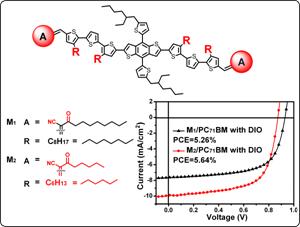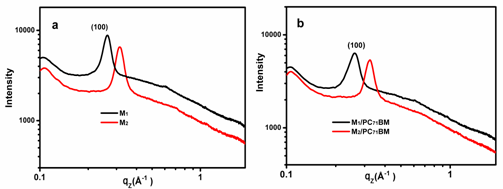| Shortening Alkyl Chains Effects on Solution-processable Small Molecules for High Performance Organic Solar Cells |
| From: PublishDate:2015-06-16 Hits: |
Solution-processable small molecules for organic solar cells (OSCs) have been investigated intensively in recent years on account of their advantages of gaining large-area, flexible, lightweight devices by roll–to–roll printing techniques, high purity, and definite molecular weight. Compared with polymers, crystallinity is particularly desirable for small molecules because of their much regular molecular structures leading to high charge carrier mobility. Shortening alkyl chains while ensuring proper miscibility with fullerene enables modulation of molecular stacking, which is an effective method for improving device performance, which is lack of investigation. A research team from National Center for Nanoscience and Technology (NCNST) studied the shortening alkyl Chains effects on light absorption, molecular energy level, hole mobility, molecular crystallinity and photovoltaic device performance. Their research has been published on the July 24th, 2014 in Advanced Energy Materials (http://onlinelibrary.wiley.com/doi/10.1002/aenm.201400538/abstract).
The team designed and synthesized a new acceptor unit oxo-alkylated nitrile (RCOCH2CN), and attached it to a conjugated backbone with ethylhexyl-thiophene substituted benzodithiophene as core and trithiophene as p-bridge. The M1 was with octyl attached to the p-bridge and the acceptor, while M2 with hexyl and pentyl attached to the π-bridge and the acceptor, respectively. The device fabricated from M1 showed a PCE of 5.26% with a Voc of 0.94 V, Jsc of 8.0 mA/cm2, and FF of 70%. The device fabricated from M2 showed a PCE of 5.6% with a Voc of 0.87 V, Jsc of 9.94 mA/cm2, and FF of 65%. The two molecules had no difference on the absorbance in the solution and film, and the hole mobilities were in the same order of magnitude.
(a) Out-of-plane scattering of films of pristine M1 and M2. (b) Out-of-plane scattering of active layer blends of M1:PC71BM (1:1.2, w/w) and M2:PC71BM (1:1.2, w/w)
The Grazing incidence X-ray diffraction was performed to investigate the crystalline of M1 and M2 in pristine films and blends using synchrotron radiation at BSRF. Results illustrated whether in the blends or the pristine films, M2 exhibited more condense packing. While, in pristine films, both M1 and M2 showed similar half wide peak width (100), however, in the blends, the width of the half peak of the (100) of M2 is much narrower than that of M1, indicating that M2 has better ordered crystalline domains in the blends than M1. Moreover, M2 has more closely p-p stacking. Ordered crystalline domains and dense p-p packing of the donor material promoted the escape of charges from the intermix phase, which leads to less bimolecular recombination, a higher utilization rate of absorbed photons, and thus, a higher Jsc. This work designed very interesting and potential acceptors, and deeply investigated the influence of shortening alkyl chains on solution-processable photovoltaic small molecules. This work would provide valuable insights into the molecular design and device optimization for OSCs. Synchrotron sources have helped the team to deeply study the effects of alkyl chains and additives on photovoltaic properties. Prof. Zhixiang Wei, the team leader at the NCNST explains "For organic solar cells, molecular aggregation and morphology have crucial effects on photovoltaic device performance, and we can make full use of synchrotron sources to establish the direct relationship between the morphology and structure, which is of great significance for us to further optimize the molecular design and to obtain higher PCE." |
|
|
| Chinese
- Metal-free efficient photocatalyst for stable visible water splitting——Top ten major scientific progresses in China in 2015
- The nano-resolution imaging platform was awarded the first rate prize of Beijing Science and Technology in 2014
- Beamline 1W1 of BSRF started to runoperate in the couplingparasitic mode of BEPCII
- Synthesis of High Performance Polymer Materials for Field Effect-Transistors
- Surfactant molecular aggregates in green solvents
- GIXRD has played an important role in the characterization of organic thin-film transistors
Copyright © 2011 - 2012 Beijing Synchrotron Radiation Facility



